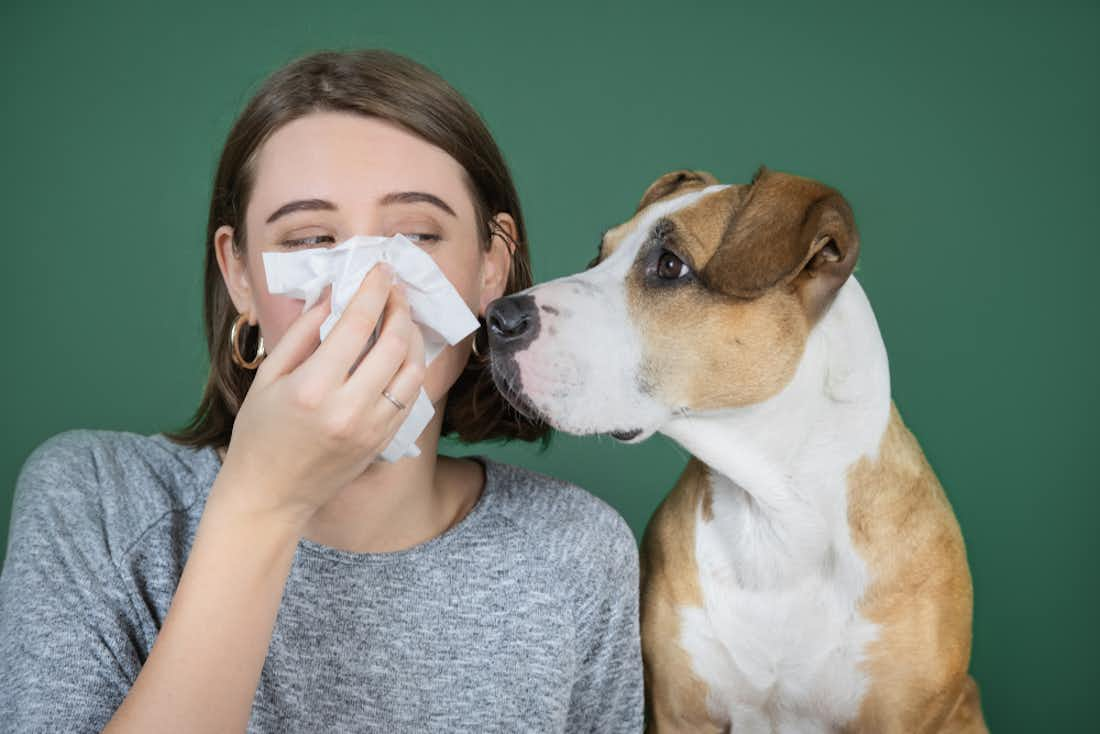Sep 22, 2022
Peanut Allergy Testing At Your Convenience: Introducing Allergenis®
4 minute read
What if you could test for a peanut allergy, know the sensitivity of your allergy with over 91% accuracy (1)(2), and do it all without leaving home?
What if you could eliminate the fear of living with a peanut allergy entirely, or know the threshold at which you might react (is it a whole peanut, or a few grains of peanut dust)?
Convenient peanut allergy testing and threshold prediction is a reality with the Allergenis® Peanut Diagnostic from Cleared.
Whether you recently had your first allergy scare or are concerned about the safety of yourself or a loved one, confirming if you have a peanut allergy––and how much peanut protein might trigger a reaction––just got a whole lot easier.
Peanut Allergy Basics
Let’s talk about allergens.
An allergic reaction occurs when the immune system perceives a harmless substance as a threat. That might be a particular pollen in the air during the spring, like ragweed, or in the case of a peanut allergy, peanut protein.
The offending substance is called an allergen.
When an allergic patient encounters an allergen, their immune system goes into overdrive, erroneously interpreting the offending allergen as a threat. For some, that might manifest as stomach discomfort or a rash, but for severe allergies it can manifest as anaphylaxis, a life-threatening allergic reaction that involves rapid swelling and possible closure of the airway, requiring immediate medical care.
People with food allergies must carry epinephrine autoinjectors (like the ubiquitous Epi-Pen®) to reverse the symptoms of anaphylaxis.
For parents of school-age children with a peanut allergy, the prospect of anaphylaxis while your child is away from home can be profoundly frightening. Children are much less aware of what they put in their mouths and the risk of exposure to allergens in their environment. A peanut butter cracker in a friend’s lunch at school can be life-threatening for children with severe peanut allergies.
Many parents and individuals with peanut allergies live in constant fear, partly due to unknowns like exactly how allergic they are.
Can a whiff of peanut protein send me into anaphylaxis, or do I have more leeway?
The Problem With Current Peanut Allergy Tests
Peanut allergy testing has been around for a long time, but the assays used for the last few decades have major shortcomings.
A skin prick test is the least invasive and involves introducing a minute amount of allergen through a tiny needle at the skin’s surface. An allergist will look for a reaction to assess whether you have an allergy.
If a skin prick test is positive, most experienced allergists will also request an IgE blood test.
When you have an allergy, your immune system has allergen-specific antibodies known as immunoglobulin E, or IgE for short.
An IgE blood allergy test analyzes how many allergy-specific IgE––in this case, peanut––antibodies you have in your blood as another way to confirm your allergy.
Here’s the problem: skin prick tests and IgE tests have a roughly 50% false positive rate. That means that 1 in 2 patients will be falsely diagnosed with a peanut allergy! For those properly diagnosed, the severity of their diagnosis is still unknown.
That leaves thousands of patients and families living in fear and making dramatic lifestyle choices to avoid contact with peanut allergens, despite the possibility that they may tolerate more peanut protein than they thought or may not be allergic to peanuts at all.
Before the Allergenis® Peanut Diagnostic, the only way to find out just how “reactive” you might be was to measure your peanut protein thresholds through a food challenge test, also known as an oral food challenge.
How Much Peanut Protein Causes a Reaction?
For people with a peanut allergy, reactions can vary based on volume of peanut protein consumed and a number of other cofactors that can make a reaction more severe.
It could mean that an allergic reaction is triggered from exposure to a few particles of peanut dust, or it might take eating an entire peanut or two before any type of reaction is evident.
This is often the most important question for those with a peanut allergy: how careful do I have to be?
When a peanut allergy is suspected, the next step is a food challenge. This method of peanut allergy testing is done in an allergist’s office under close observation. The patient ingests increasing doses of peanut protein over the course of four to five hours and is monitored for response. The goal is to gauge the threshold at which the patient reacts, if at all.
Peanut allergy food challenge dosing generally begins at 4 milligrams (mg) and climbs to a single 10 gram (g) dose, or about two whole peanuts in the final step.
Understanding the threshold at which a child reacts to peanut protein can help parents plan accordingly. A bite of a peanut butter & jelly sandwich is much easier to avoid than a hint of peanut powder.
Unfortunately, a peanut protein challenge is stressful, time consuming, and can be terrifying for the patient and parents! Will your child have an anaphylactic reaction? Will epinephrine work? Are you headed to the hospital?
Additionally, facilities that are equipped to conduct food challenges are uncommon, and many physicians avoid the practice outright due to inherent health risks and liability.
That’s why an effective, alternative peanut allergy test that can be done from the comfort of home without a food challenge is so profound for parents and children.
That’s why Allergenis® exists.
A Peanut Allergy Diagnosis without Leaving your Home
The Allergenis® Peanut Diagnostic harnesses a new and exciting approach to testing for peanut allergies, reliant on a small blood sample rather than a peanut food challenge or skin and IgE blood tests with high false positive rates.
The Allergenis® Peanut Diagnostic goes much further than a standard blood or skin prick test by:
- identifying whether the patient is allergic with a positive predictive value of 91% and negative predictive value of 95%
- measuring the body’s predicted immune response to peanuts to predict a threshold for reaction –– that is, the amount of peanut protein that an individual can tolerate before triggering a reaction
The test involves pinpointing the locations where IgE antibodies bind to peanut protein, called epitopes. Allergenis® researchers and founders pioneered the science behind assessing these binding sites on the peanut protein.
In the real world, and for concerned parents, epitope reactivity level is an accurate indicator of how much peanut protein it may take to generate a dangerous immune response.
When you order the Allergenis® Peanut Diagnostic, a Cleared doctor prescribes the test, and a licensed phlebotomist is scheduled to come to your home (or location of your choice) at your convenience for a quick and painless blood draw. Your sample is sent to the Allergenis® lab, where it’s evaluated for epitope reactivity and your results returned by email.
The Peanut Diagnostic returns one of three outcomes:
- Level 1 is the most reactive. 92% of those in this group tolerate 4 milligrams of peanut (a tiny amount of peanut protein), and only 49% can tolerate 44 mg, or about a quarter of a peanut. Fewer than 30% of patients at Level 1 can tolerate 144 mg, about half a peanut).
- Level 2 is moderately reactive. In this group, about 83% of patients can tolerate 44 mg, and about 65% can tolerate 144mg, or a half a peanut.
- Level 3 is the least reactive. In this group, 84% of patients can tolerate around 144 mg (or half a peanut), and 73% could eat 444 mg or about 1.5 peanuts without reacting.
Epitope reactivity level has been validated to the same American and European standards (PRACTALL) that serve as dose guidelines for the most common oral food challenges in use today.
The testing process for the Allergenis Peanut Diagnostic was rigorously validated under the National Academy of Medicine’s (NAM) guidelines for test development, and every sample was confirmed with a double blind placebo controlled oral food challenge, the gold standard in food allergy diagnostics. Allergenis’ laboratory is CLIA-certified and specializes in this immunological research into epitope mapping technology and food allergies.
Put simply, the Allergenis diagnostic is a major leap forward in peanut allergy testing, and allergists nationwide are embracing this new testing technology due to its ease, safety, and accuracy.
Advantages of Allergenis’ Peanut Diagnostic
The advantages of Allergenis’ convenient peanut diagnostic are multifold.
“You either react or you don’t,” says Jim Garner, CEO of Allergenis. “Not all patients react to very trace amounts. Ours is the first blood test to be able to reveal these thresholds.”
- Peace of mind. Understanding whether you or your child can eat food with “may contain peanuts” labeling with relatively low risk of reaction can be a breakthrough for concerned parents unsure where their child falls on the reactivity scale.
- Conclusive: The test is more accurate than any other “non invasive” test, including common blood IgE tests and skin prick tests, with a sensitivity of 92%, specificity of 94%, a positive predictive value of 91%, and negative predictive value of 95%.
- Safety. Despite being done in the relative safety of a doctor’s office, food challenges are scary for parents and their children, and the small risk of something going significantly wrong remains. The Allergenis Peanut Diagnostic can obviate the need for this procedure altogether or better inform the right beginning and ending doses for your allergist.
- Simplicity. Done from home in minutes, the Peanut Diagnostic is convenient and cost-effective.
How to Get A Peanut Allergy Test That Can Be Performed At Home
Cleared has partnered with Allergenis to offer this breakthrough diagnostic to everyone, just about anywhere.
To get started, order your test from Cleared by clicking here and completing the quiz to see if you’re eligible (and get 50% off with promo code PEANUT50).
Next, your Cleared doctor will review your quiz answers and send your kit for fulfillment once you are confirmed to be eligible. Allergenis will send a mobile phlebotomist to your location. To schedule your small blood draw, you will receive an email and a text message from Allergenis. In the case of a child, a phlebotomist who specializes in pediatric draws will be sent.
After your visit, your sample is sent straight to Allergenis’ CLIA-certified laboratory where it undergoes epitope mapping.
Once your results are ready, your Cleared doctor will email your results and, if you want, you can also schedule a virtual consultation to help you understand what your diagnosis means and plan for your future. You should always speak with a board certified allergist about your results before making any changes to your diet.
The process is quick and painless, and in no time you can have answers to some of your most pressing questions.
“Now I don't have to worry so much if we're at a friend's house and they have peanuts out. There's not that same level of anxiety, so it's huge, I'm so happy." - Marci
A peanut allergy diagnostic has never been easier or more informative. Get started today with a Cleared doctor by clicking here.
References
Authors

Dr. Payel Gupta
Medically reviewed by Dr. Payel Gupta



